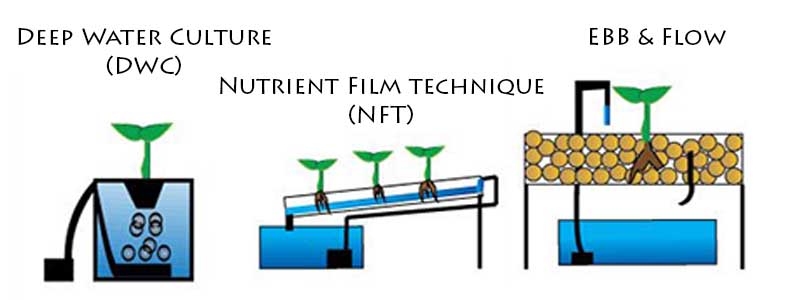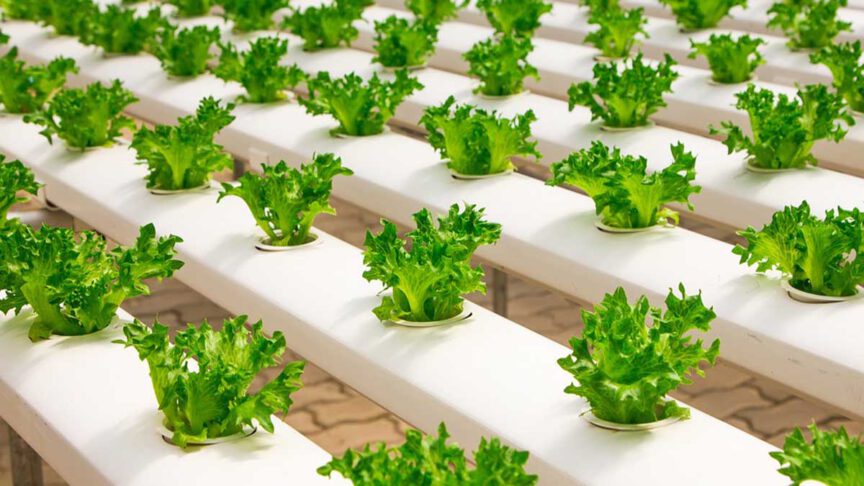The nutrient film technique (NFT)
The nutrient film technique, is one of the most used Hydroponic System types. In this technique, the nutrient solution is pumped from a reservoir through pipes or channels, which are housing the plants. Then the solution flows back into the reservoir and goes through the process again. Typically, the water pump would run every 30 minutes for 30 minutes, though this time can be adjusted to the needs of the plant.
Depending on the size of the plants, different channel sizes can be chosen. Though I would recommend plants without large root systems, since there is only limited space for the roots within the channels.
Hydroponic NFT systems are perfect for small to medium-sized systems. I have even seen some quite large NFT systems in my time, though I would recommend other techniques for large commercial Hydroponics.
Deep water culture Hydroponics (DWC)
In this Hydroponic type, the plants sit directly on top of the reservoir. Typically, a large non-transparent box is used, with holes for the net pots in the top. The roots of the plants can then grow into the nutrient solution. This technique is more viable for larger plants, as you can easily adjust the space each plant has for its root system.
This technique is mostly used by newer Hydroponic growers, since it has one great advantage: You don’t need a water pump for this system. Of course, you still need to supply your plants with oxygen, but that can be done with an air stone or something similar, which is a lot cheaper.
Deep Water Culture Hydroponics is also great for DIY Hydroponic systems. I have built my first Hydroponic System for under $50, and it was a deep water culture System.

The ebb & flow / flood & drain technique
This Hydroponic technique is similar to DWC Systems, though it has one major difference. In flood & drain Hydroponics, the plants are separated and periodically get flooded with water from the reservoir. This is a healthy combination of the DWC and NFT techniques. It does require more of a substrate solution though. You can read more about Hydroponic substrates here.
You have as much space for the root systems of the plants as you want, since you can freely choose the size of your reservoirs. And you have the periodic element of the NFT technique, since the water pump will only run on a timer, not constantly. This makes for enough time for the plants to take in oxygen from the surrounding air. That’s in addition to the oxygen that’s contained in the water itself, of course.
You have as much space for the root systems of the plants as you want, since you can freely choose the size of your reservoirs. And you have the periodic element of the NFT technique, since the water pump will only run on a timer, not constantly. This makes for enough time for the plants to take in oxygen from the surrounding air, in addition to the oxygen that’s contained in the water itself.
Which Hydroponic system type to choose?
If you are just starting out with Hydroponic growing, I would advise to build your own little DWC System. It is cheap, and they are great to learn about Hydroponics, without spending a lot of money on it.
Once you have gathered some experience and feel like you want to expand, you can go for a different one of the Hydroponic system types. A small NFT System would be a good next step, in my opinion. Maybe put it on a free wall, if you are not doing it outside. With NFT, you can go quite large without needing a massive water reservoir, so it can easily be inside.
These two techniques are what I would recommend getting started with. If you are not advanced in Hydroponic growing, learn the ropes with DWC and small NFT Systems. Then, with some experience, you can try out the flood & drain technique. It does have more advantages, but it is also easier to mess up.


Comments
Pingback: How Vertical Farming works with hydroponics – Just Hydroponic
Pingback: Water Pumps choice for Hydroponics and Aquaponics – Just Hydroponic
Pingback: Things to consider before starting with Hydroponics – Just Hydroponic